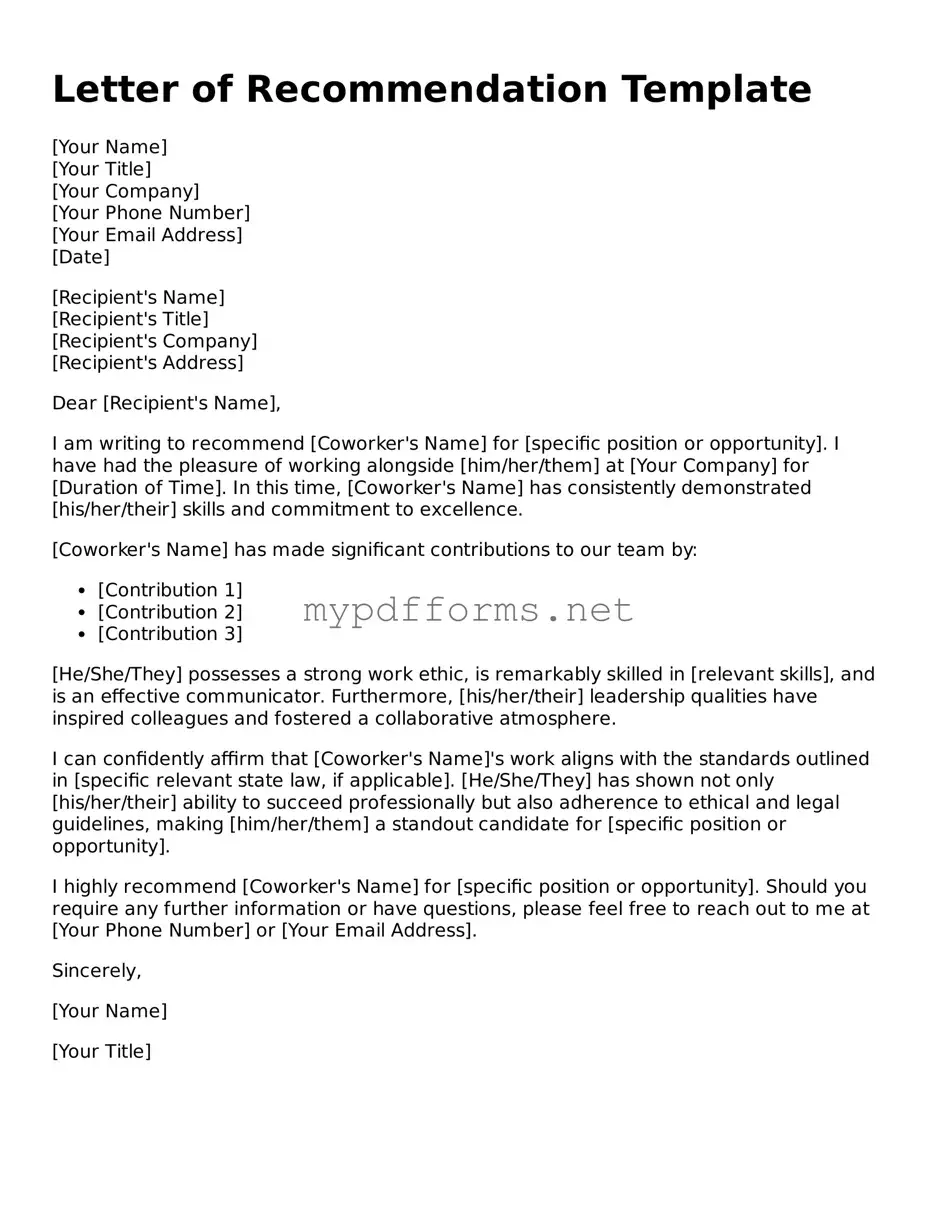The Letter of Recommendation for Coworker form shares similarities with the Letter of Recommendation for Graduate School. Both documents aim to highlight an individual's skills, work ethic, and accomplishments. In the context of graduate school, the recommender emphasizes the candidate's academic abilities and potential for success in advanced studies. Each letter is tailored to the recipient's needs, showcasing relevant experiences that support the individual's application.
Another document akin to the Letter of Recommendation for Coworker is the Reference Letter for Employment. This letter is often requested by job seekers to provide potential employers with insights into their professional capabilities. Like the coworker recommendation, it includes specific examples of the individual's strengths and contributions in a work setting. Both letters serve to validate the candidate's qualifications and character, enhancing their chances of securing a position.
The Letter of Recommendation for Scholarship applications also parallels the coworker form. This document is designed to support a student's application for financial aid by detailing their academic achievements and personal qualities. The recommender highlights the applicant's dedication, leadership, and potential impact, similar to how a coworker recommendation would focus on professional attributes relevant to the workplace.
Additionally, the Character Reference Letter is another document that shares a common purpose with the Letter of Recommendation for Coworker. This type of letter emphasizes personal qualities and character traits rather than professional achievements. It is often used in legal situations, job applications, or community service roles. Both letters aim to provide a well-rounded view of the individual, focusing on attributes that make them a suitable candidate for a specific opportunity.
The Performance Review can also be compared to the Letter of Recommendation for Coworker. While a performance review is typically an internal document, it assesses an employee's job performance and contributions. Both documents highlight strengths and areas for improvement, but the recommendation letter is more forward-looking, aiming to support future opportunities. Each serves to provide feedback that can influence career advancement.
The Letter of Support for a Grant application is another document with similarities. This letter is written to endorse an organization or individual seeking funding. It outlines the qualifications and capabilities of the applicant, much like a coworker recommendation. Both documents aim to persuade the reader of the applicant's merit and potential for success in their respective endeavors.
The Personal Statement often accompanies applications for various opportunities, including jobs and educational programs. While it is a self-authored narrative, it shares the intent of showcasing an individual's qualifications and aspirations. Both the personal statement and the coworker recommendation seek to present the candidate in the best light, although the former relies on the individual's own voice and experiences.
In situations related to custody agreements, a Character Reference Letter for Child Custody can play a key role in influencing court decisions. This letter highlights the parent's qualities and their ability to foster an environment suitable for a child’s well-being, providing vital information that might not be evident in legal documents. For further guidance in crafting such a letter, you may refer to helpwithlegalforms.com.
The Endorsement Letter for Professional Membership is similar in that it supports an individual's application to join a professional organization. This letter highlights the candidate's qualifications and contributions to their field, akin to how a coworker recommendation underscores professional capabilities. Both documents serve to validate the applicant's membership and potential contributions to the organization.
Lastly, the Testimonial Letter is comparable to the Letter of Recommendation for Coworker. This letter serves as a personal endorsement of someone's skills or character, often used in various contexts, including business and personal references. Like the coworker recommendation, it provides insights into the individual's abilities and reliability, aiming to affirm their suitability for a specific role or opportunity.
